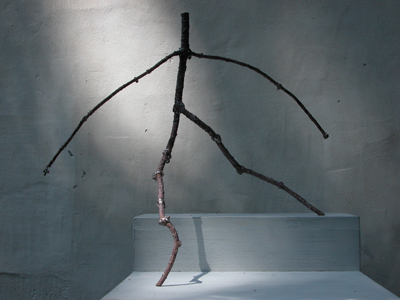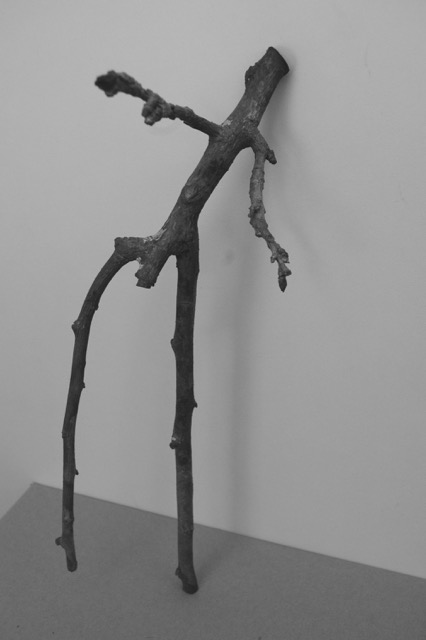«What a surprise! Huge goblins fill the room. Although the figures are firmly fixed, a dance festival seems to take place: Some sway and bend, others strut around or watch in calm silence what is going on.»
Peter Killer, art historian, former co-editor of the culture magazine "Du", former art critic Tages-Anzeiger
INFOS
The museum is accessible when the Kabinett restaurant is open.
Monday 6-10 pm
Thursday & Friday from 10am-10pm
Special opening hours and guided tours on request from the Kabinett management.
The entry to the museum is free of charge.
Guided tours on request Fr. 100
(with the artist Alfons Bürgler Fr. 140)
Duration depending on the group: 1-2 hours
Nathalie von Arx and Denise Pfyl are responsible for guided tours, private events and the operation of the Kabinett.
The "Tree Figure Cabinet" by artist Alfons Bürglers is a continuation of his longest and most successful creative phase "Body Writings" and fascinates viewers, buyers and critics alike.Grown trees, literally turned upside down by the artist Alfons Bürgler, can be seen in this gallery as goblins, women, men, lovers and dancers. In the associated AMBIENTE, encounters and exchanges take place. Since 2008, countless schools, groups or associations have visited this idiosyncratic little museum. In the meantime, it has developed into a popular cultural and meeting place in Steinen, which must be preserved. In August 2020, the artist therefore handed over the responsibility for reasons of age to the VEREIN BAUMFIGUREN-KABINETT ALFONS BÜRGLER, which wants to preserve the tree figure cabinet with him.
TREE FIGURES
In 2003 Alfons Bürgler discovered his first tree figure in a bush, a small branch with two "legs" and two "arms". The accidental discovery was the beginning of a series of sculptures that still occupies him today. For these sculptures (human-like figures) he does not need the tools typical of wood sculptors, but only saws and pruning shears. He saws his tree figures from bushes and trees, which he finds in hedges and on forest edges. He specifically searches bush and tree branches for forms that he can turn into figures when turned 180 degrees. The smallest of the tree figures are a few centimeters high, the largest about three meters.
Pictures about the invention of the tree figure
BRONZE CASTING

This technique is one of the oldest and most commonly used methods for making metal sculptures and jewelry, practiced as early as the 3rd millennium BC in the Bronze Age. Here is a detailed description of the lost mold process:
1. Modeling: the artist or craftsman first creates a detailed model of the desired sculpture or piece of jewelry out of wax, clay or another malleable material. The model should exactly match the finished object, including all details and embellishments.
2. Creating the mold: To create the mold, the wax model is covered with a refractory layer, e.g. of clay, plaster or a special refractory mixture. This layer is carefully applied to capture all the details of the model. The outer layer is then dried to create a solid mold.
3. Removing the wax model: After the outer layer is completely dry, the mold is heated to melt and drain the wax model inside. This step leaves an empty hollow mold that replicates the exact shape of the original wax model. Hence the name "lost mold".
4. Casting: The molten metal, e.g. bronze, gold or silver, is poured into the empty hollow mold. The metal fills the cavities previously occupied by the wax model and takes on its shape.
5. Cooling and removing the mold: Once the metal has cooled and solidified, the outer refractory layer is carefully removed to reveal the finished metal sculpture or piece of jewelry.
6. Finishing: The metal sculpture or piece of jewelry is then polished, finished or patinated to achieve the desired look. If necessary, connecting pieces or other details are added.
The lost mold technique allows for the creation of detailed and complex metal sculptures and jewelry that would be difficult to achieve with other casting methods. The technique is still used today by artists, jewelry makers and craftsmen and is an important part of the history and tradition of metalworking.
DOWNLOAD
LOGO:  PDF JPG AI eps svg tif
PDF JPG AI eps svg tif
Fotos: Alfons Bürgler JPG Baumfigur JPG
PUBLICATIONS OF ALFONS BÜRGLER
Katalog «BAUMFIGUREN», 2008
Katalog «glaskunstambau», 2007
Katalog «Werkauswahl 2001 - 2004»
Katalog «Werkauswahl 1999 - 2000»
Monographie und ausführliche Biographie mit 221 farbigen Abbildungen von Werken aus den Jahren 1952 - 1999
19 Archiv-Kataloge, erhältlich bei blurb.de >
Katalog 1 1960 - 1983
Katalog 2 1983 - 1986
Katalog 3 1986 - 1991
Katalog 4 1991 - 1998
Katalog 5 1998 - 2011
Katalog 6 2012 - 2013 «Spezielles» im Anhang
Katalog 7 1965 - 1980
Katalog 8 1981 - 1989
Katalog 9 1984 - 1985
Katalog 10 1986 - 1987
Katalog 11 1988 - 1990
Katalog 12 1991 - 1996
Katalog 13 1997 - 2003
Katalog 14 2004 - 2007
Katalog 15 2008 - 2010
Katalog 16 2011 - 2013
Katalog 17 2014 - 2016
Katalog 18 1970 - 1985
Katalog 19 1986 - 2019
Katalog 20 «Kinder von Hünenberg»
Katalog 21 «Menschen in Gesellschaft»
Katalog 22 «Reiseerinnerungen»


